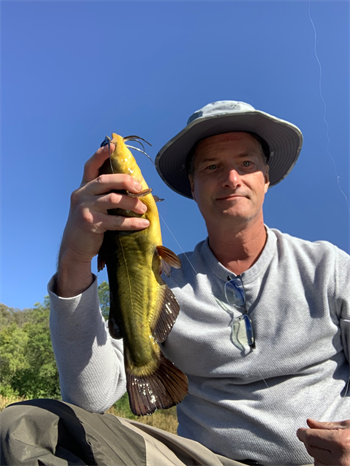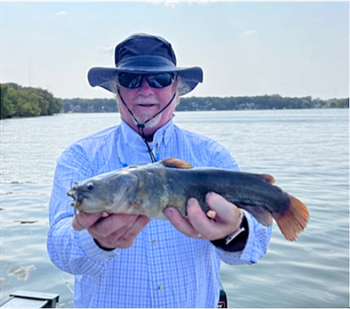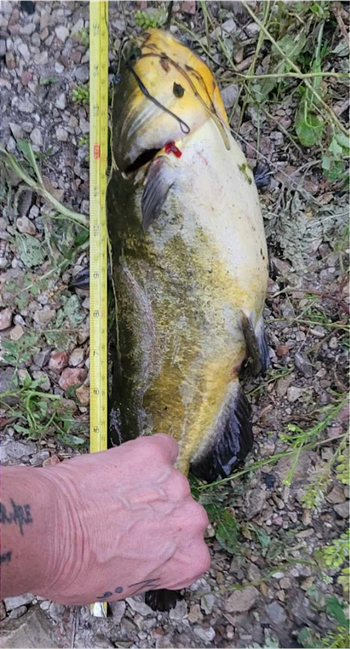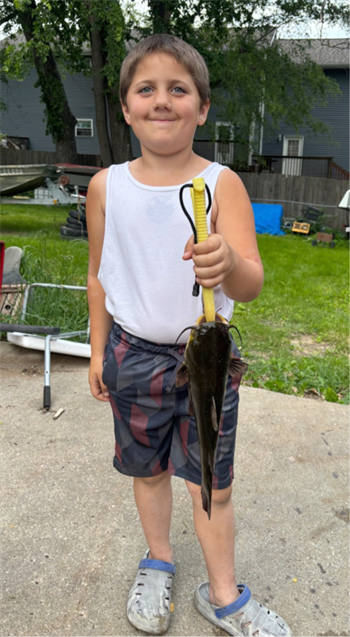Fish Iowa - Fish Species - Black Bullhead
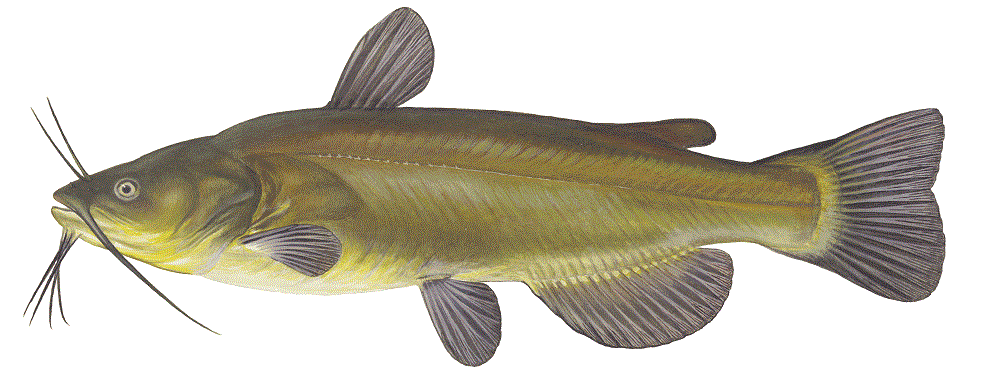
Characteristics
Usually dark olive to black on the body, although it becomes light brown in some waters. The belly is usually white, but the color varies, and the belly is bright yellow in certain lakes and larger rivers, especially in early spring and during the breeding season. The chin barbels are dusky or black. This fish can be distinguished from the other bullheads by the light colored band at the base of the tail and the 17 to 20 rays in the anal fin. The tail fin is slightly notched, and the outer two-thirds of the fleshy membrane of the anal fin is uniformly black or dark-pigmented. The backside of the pectoral spine is weakly barbed. This fish is rarely mottled in color.
Foods
Strictly omnivorous; eating almost everything in the water. Midge and mayfly larvae make up most of the diet, but it also eats other insects and their larvae, small crayfish, worms, small mollusks, crustaceans, and many other animals and plants. Bullheads eat the eggs of other fishes, as well as feeding extensively on minnows. Fathead minnow,abundant in most Iowa lakes and streams, is of particular importance in their diet.
Expert Tip
1/2 a night crawler is bullhead candy - use long shank hooks to make it easy to remove the hook!
Details
The Black Bullhead lives in a variety of aquatic habitats including; backwaters, oxbows, sloughs, bayous, swamps, marshes, ponds, natural lakes, reservoirs, pools of intermittent streams and tributary confluences. It is found in almost all size streams. The largest populations are in low-gradient segments of small to moderate sized streams. They are often found in quiet silt-bottomed backwater areas and pools away from strong currents, living in water with low diversity of fish. They are tolerant of siltation, pollution, high temperatures, as well as areas with low oxygen levels.
The Black Bullhead spawns in May or early June, usually in weedy or muddy shallow areas. They build saucer-shaped nests in the mud or sand in about 2 to 4 feet of water. These nests are about 6- to 14-inches in diameter and up to l0-inches deep. The number of eggs deposited depends on the age and size of the female, but the average is about 2,000 to 6,000, or more. Incubation is completed in a week or less under normal conditions. The young fry stay in tight black, ball-like schools until they reach almost 2 inches long and leave their parents to care for themselves. It is usually the smallest-sized bullhead, but in larger lakes of northern Iowa some reach two pounds or more. In streams or lakes where food is scarce and the population density is high, they are much smaller and seldom more than 7- to 9-inches.
Recent stream sampling information is available from Iowa DNR's biological monitoring and assessment program.
Sources:
Harlan, J.R., E.B. Speaker, and J. Mayhew. 1987. Iowa fish and fishing. Iowa Conservation Commission, Des Moines, Iowa. 323pp.
Loan-Wilsey, A. K., C. L. Pierce, K. L. Kane, P. D. Brown and R. L. McNeely. 2005. The Iowa Aquatic Gap Analysis Project Final Report. Iowa Cooperative Fish and Wildlife Research Unit, Iowa State University, Ames.
Illustration by Maynard Reece, from Iowa Fish and Fishing
Learn more about this fish at the Bullhead Profile DNR Homepage
Distribution Map
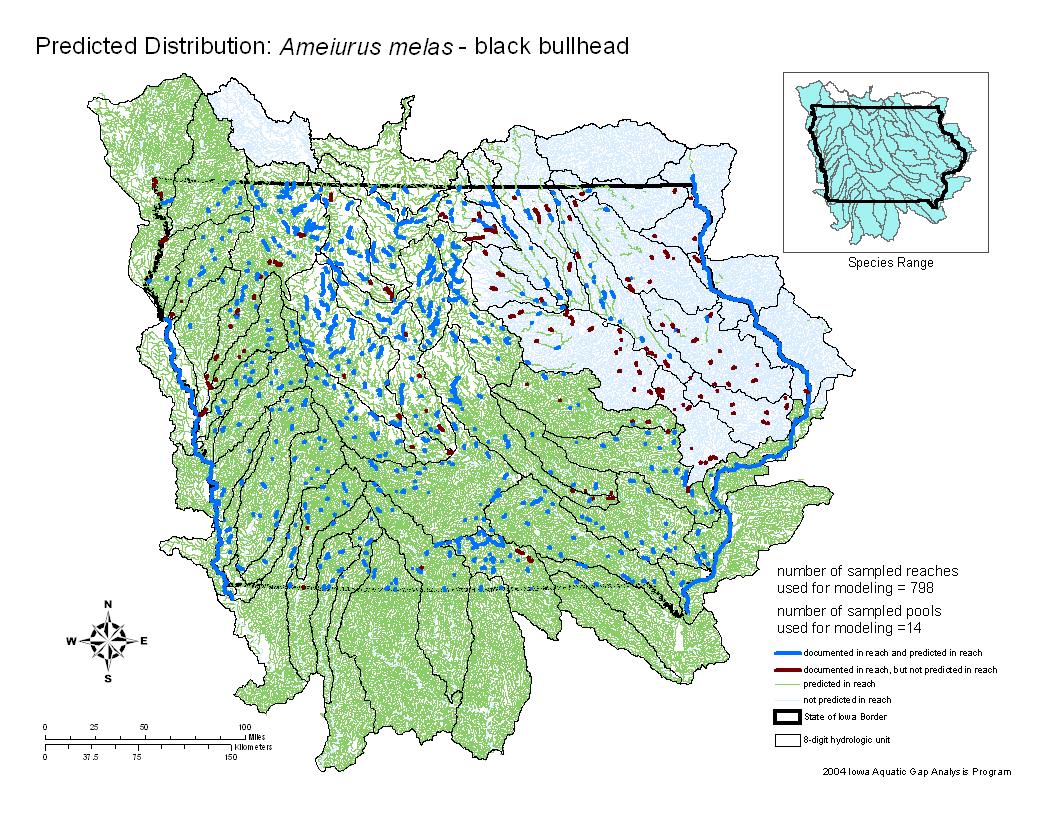
Statewide. The Black Bullhead is the most common and widely distributed of the three bullhead species found in Iowa. It is abundant in most of the natural lakes and in some man-made lakes. It can be found in many farm ponds and is taken less often in some of the oxbow lakes that overflow from the major interior rivers. Black Bullheads are occasional to common in the river impoundments, although they are usually rare in flowing waters. It is common in the backwaters and some sloughs of the Mississippi River, but its dislike of flowing water limits its abundance in the Missouri River.
See our most recent distribution data for this species on the Iowa DNR's Bionet application.
State Record(s)
Master Angler Catches
Fish Surveys
Tip: Click Species Length by Site, then use the dropdown to filter by fish species of interest.Where this Fish Is Found
Alice Wyth Lake
Ambroson Pit (north)
Art Center
Atlantic Quarry Pond 3
Avenue of the Saints Pond
Badger Creek Lake
Bartlett Lake
Big Sioux Recreation Area
Big Sioux River
Binder Lake
Black Hawk Lake
Blue Lake
Brinker Lake
Burt Lake
Cardinal Marsh
Cedar Lake
Cedar River (above Nashua)
Cedar River (Cedar Rapids to Moscow)
Cedar River (La Porte City to Cedar Rapids)
Center Lake
Crawford Creek Impoundment
Criss Cove County Park Pond
Des Moines River (Saylorville to Red Rock)
Des Moines River (Stratford to Saylorville Lake)
Diamond Lake
Diamond Lake
East Bergfeld
East Lake (Lenox)
East Okoboji Lake
Elk Lake
Elm Lake
Five Island Lake
Grade Lake
Green Belt Lake
Green Island Lake
Green Valley Lake
Greenfield Lake
Hacklebarney West
High Lake
Hooper Area Pond
Independence Impoundment
Ingham Lake
Interstate Park Lake
Iowa Lake (Emmet Co.)
Iowa Lake (Iowa Co.)
Iowa River (Coralville Lake to River Junction)
Iowa River (Iowa Falls to Marshalltown)
Iowa River (Marshalltown to Coralville Lake)
Iranistan Pond
Kuhn W.A. Quarry
Lake Cornelia
Lake Hendricks
Lake Icaria
Lake Keomah
Lake Macbride
Lake Manawa
Lake Odessa
Lake of Three Fires
Larson Lake
Little River Watershed Lake
Little Sioux River (Correctionville to Missouri R)
Little Sioux River (state line to Linn Grove)
Little Spirit Lake
Little Swan Lake
Lizard Lake
Lost Island Lake
Lower Gar Lake
Main Street Pond
Marble Lake
Martens Lake
Middle Sabula Lake
Mill Creek (Lake)
Miller
Minnewashta Lake
Missouri River (Council Bluffs to state line)
Missouri River (Little Sioux to Council Bluffs)
Missouri River (Sioux City to Little Sioux)
Mohawk Park Lake
Morse Lake
Murphy Lake
North Raccoon River (above Auburn)
North Raccoon River (Perry to Van Meter)
North Twin Lake
Orient Lake
Pickeral Lake
Pierce Creek Pond
Plainfield Lake
Pool 16, Mississippi River
Pool 18, Mississippi River
RAPP Park Lakes
RecPlex Pond
Rock Creek Lake
Ross Area Pit
Saylorville Reservoir
Scharnberg Pond
Schmerse W.A. Pond
Silver Lake (Dickinson)
Silver Lake (Palo Alto)
Silver Lake Marsh
Sluggo's Pond
South Skunk River (Cambridge to Pella)
South Twin Lake
Spirit Lake
Summit Lake
Swan Lake
Swan Lake
Trumbull Lake
Turkey River (above Clermont)
Tuttle Lake
Upper Gar Lake
Vernon Springs Impoundment
Wapsi River (Trout Section)
Wapsipinicon River (state line to Tripoli)
Wapsipinicon River (Troy Mills to Oxford Junction)
West Lake (Osceola)
West Nishnabotna River
West Okoboji Lake
West Swan Lake S.W.M.A.
West Twin Lake
Winnebago River
Wolf Creek West

